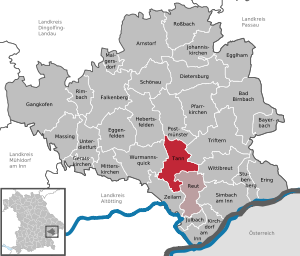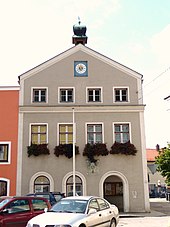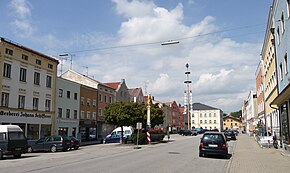Tann (Lower Bavaria)
| coat of arms | Germany map | |
|---|---|---|

|
Coordinates: 48 ° 19 ' N , 12 ° 54' E |
|
| Basic data | ||
| State : | Bavaria | |
| Administrative region : | Lower Bavaria | |
| County : | Rottal Inn | |
| Management Community : | Fir | |
| Height : | 447 m above sea level NHN | |
| Area : | 37.57 km 2 | |
| Residents: | 3960 (December 31, 2019) | |
| Population density : | 105 inhabitants per km 2 | |
| Postal code : | 84367 | |
| Area code : | 08572 | |
| License plate : | PAN, EG, GRI, VIB | |
| Community key : | 09 2 77 148 | |
| Market structure: | 105 districts | |
Market administration address : |
Marktplatz 6 84367 Tann |
|
| Website : | ||
| Mayor : | Adi Fürstberger | |
| Location of the Tann market in the Rottal-Inn district | ||
Tann is a market in the Lower Bavarian district of Rottal-Inn and the seat of the administrative association Tann .
geography
Geographical location
Tann is located in the southeast of Lower Bavaria in its typical hilly landscape about 13 km northeast of Simbach and 14 km from Braunau , 16 km southwest of the district town of Pfarrkirchen , 16 km southeast of Eggenfelden and 23 km each from Burghausen and Altötting . The nearest train station is in Marktl, eleven kilometers away .
Community structure
The market town of Tann includes the Tann market, the parish villages of Eiberg , Walburgskirchen and Zimmer as well as the villages of Breitenberg , Fraunleiten , Grasensee , Hiltraching and Nuremberg . There are a total of 105 places in Tann which, apart from the villages already mentioned, are hamlets and wastelands :
|
|
|
|
history
Until the 18th century
The first documentary mention comes from the year 927, it is in connection with the Salzburg Archbishop Adalbert II . The "noble von Tann" are documented around 1060 and in other documents are in the years 1100–1200 a. a. a Reimbert von Tann, a Reginbrecht von Tann and a Hartmann von Tann are mentioned. After the Tanner noble family died out around 1200, the Tann castle and rule passed to the Counts of Leonberg . After their extinction, the Counts of Hals inherited for the time being in 1319, and in connection with inheritance disputes, the properties finally came to the Counts of Ortenburg in 1379 . In 1386 Tann was bought by the Duchy of Bavaria and market rights were granted as early as 1389 . In 1481 Tann was given the right to hold markets. The Martini market, which is still held today, dates back to this year. In other sources it is assumed that as early as 1230 Duke Ludwig I granted the right to hold public markets.
The first wool and linen weaving mills came into being around 1300, and in the following centuries they became famous in European trading centers with their quality products. The trade in sailcloth in particular led the Tanner linen weavers and drapers to the seaports of Trieste , Venice , Genoa and Amsterdam . But the place also suffered agonizing times with plague epidemics, the Thirty Years War and the wars of succession of the 18th century. Around 1743 Tann was occupied by the Pandours . For the cloth makers, however, the production of red fabrics for their uniforms brought a good income.
19th century
In the 19th century the Tanner cloth makers declined. Trapped in their frozen classiness, they were neither able to face the social and societal developments nor to use the emerging mechanization to their advantage. The separation of the Innviertel from Bavaria and the establishment of the German Customs Association in 1834 also contributed to this development . Towards the end of the 17th century, the annual pilgrimage to "Herrgott von Tann" developed , which in the following 200 years also gained economic importance for the place. Therefore, despite the increasing secularization , the new building of the current church began in May 1799 without government approval. It was finally inaugurated on May 13, 1805 by the Archbishop of Salzburg.
Nevertheless, Tann became an independent parish relatively late, not until 1849, until then it was a subsidiary of Zimmer. In a major fire on November 17, 1885, part of the village was destroyed, especially in the direction of Schildthurn .
20th century
Although the Second World War ended for Tann in the late afternoon of May 1, 1945 with the invasion of the US Army without any combat action, these days and the period that followed were a special challenge for the place. Fleeing from the Red Army , more than 50,000 Hungarians (civilians and military) had already reached Tann a few days earlier with the intention of surrendering to the Americans. In a formal ceremony on the market square, US Major General Millikin (John Millikin, 1888-1970) accepted the surrender from Ex-Prime Minister Ferenc Szálasi and the Commander in Chief of the Hungarian Armed Forces Károly Beregfy . The headquarters of the 13th US Army Panzer Division was set up in Tann for the entire period of occupation, and a large prison camp was immediately built in the area of today's Mitterfeldstrasse. Around 20,000 prisoners of war, mostly former members of the Wehrmacht, were smuggled through here or released into civilian life. With the integration of many expellees , an Evangelical Lutheran parish grew after 1945. The Trinity Church was built in 1958 and 1959 according to plans by the architect Hanns Egon Wörlen from Passau .
21st century
Contrary to the plans of the community, the use Grainerbräu building partly as administrative offices, won on 10 April 2011, a referendum with 62% of votes. Which was launched citizen initiatives from the established on this topic citizens' initiative "We for Tann" (WFT). A council petition put forward by the municipality on the day of the federal election in 2013 won with 56% and thus overturned the referendum's resolution. As a further consequence of this discussion, “Wir für Tann” moved into the municipal council with 4 seats in the 2014 local elections.
After prolonged rainfall , the center of Tann was flooded on June 1, 2016 and made several streets impassable.
Incorporations
In the course of the regional reform in Bavaria , the area of the municipality, which until then had only included the current town center, was enlarged significantly on January 1, 1972. Local areas of the former communities Randling and Schildthurn were included and the current community was formed with the previously independent communities Walburgskirchen and Zimmer and parts of the dissolved community Rogglfing. An administrative partnership was entered into with the municipality of Reut . On January 1, 1980, an area in each of the communities of Reut and Zeilarn , each with a little less than 100 inhabitants, was reclassified to Markt Tann.
Population development
Between 1988 and 2018 the market grew from 3,269 to 3,971 by 702 inhabitants or 21.5%.
politics
Market council
The market town council consists of the 1st mayor and 16 market town council members. The municipal council election on March 16, 2014 led to the following distribution of seats in the municipal council:
| Party / list | Share of votes | Seats |
|---|---|---|
| CSU | 38.4% | 6th |
| Free voter community Walburgskirchen Land | 21.3% | 3 |
| Christian community of voterszimmer-Eiberg | 17.6% | 3 |
| We for Tann | 22.5% | 4th |
mayor
Adi Fürstberger (CSU) has been mayor since May 2002. In the 2014 local elections, he was confirmed in office with 68.4% of the valid votes.
coat of arms
Blazon : A green fir tree in red on a green three-mountain, accompanied on the right by a standing blue diamond, on the left by a standing silver diamond.
Culture and sights
- Classicist parish church of St. Peter and Paul , built from 1798 to 1801
- Historic market square in the Inn-Salzach style with the central Marienbrunnen
Culture
Several institutions shape the cultural life of the place. These include:
- Tanner culture centrifuge e. V.
- Culture e. V.
- Thalia Theater-Tann e. V.
- Walburgskirchen theater group
Sports
The gymnastics and sports club Tann (TSV Tann) from 1891, with the divisions women's gymnastics, football, running group, ski club, stick shooters , tennis and table tennis is the largest sports association in the community with almost a thousand members. Further sporting activities can be found at the Stockschützen, at EC Walburgskirchen and for winter sports enthusiasts at the Langeck Ski Club. The TUS Walburgskirchen is home to the football activities there. Although the association Feuerschützen Tann is also a traditional club, it has to be assigned to sports activities. They regularly come up with national successes right up to the state level.
Economy and Infrastructure
Volunteer firefighter
In all four municipalities, independent, well-trained volunteer fire brigades are still operated by well-trained emergency services. The Tann volunteer fire brigade is a fire brigade equipped with modern vehicles and equipment.
education
While the primary and secondary school Tann belongs to a school association with Reut and Zeilarn, the primary school Walburgskirchen is operated independently by the municipality of Tann. The two kindergartens in Tann and Walburgskirchen are municipal institutions.
Senior care
The Zum Laaberg nursing home in Eiberg and the Tann retirement home e. V. in Tann are operated by private companies.
Church facilities and activities
- Catholic parish association Tann with the parishes Tann, Eiberg, Zimmer, Walburgskirchen, Taubenbach and Reut
- Evangelical Parish Tann.
- Catholic Workers' Movement (KAB)
- Catholic women's union, each in Eiberg, Tann, Walburgskirchen and Zimmer
- Catholic rural youth (KLJB)
Regular events
- The wax market , a market that has always been very popular with political rallies in several inns, takes place on the Thursday before Candlemas (February 2nd).
- The solstice fire of the volunteer fire department takes place on the weekend around June 24th.
- The popular wine festival takes place on the 2nd weekend in August . This is supported by the fire protection company Tann e. V. organized and held.
- The art market on the last Sunday in August has developed in this form since 1986 from the traditional Bartholomäusmarkt . The "open air" events are well received by all sections of the population from near and far.
- A commemoration of the country teams at the memorial of the German East on the frame mountain will take place on a Sunday in mid-September. The organizer is the Tanner Association for the Promotion of the Memorial to Displaced People .
- The Martini market on the second Sunday in November has over 600 years of tradition in Tann.
- The Nikolausmarkt takes place on the Saturday before December 6th.
- Every December 22nd, the voluntary fire brigade Markt Tann organizes the winter solstice celebration
Personalities
- Max Heuwieser (1878–1944) was professor of world history and historical auxiliary sciences at the Philosophical-Theological University of Regensburg and co-founder of the Institute for East Bavarian Local History .
- Pastor Franz Xaver Neun : In 1954, a church wedding went through the press nationwide, more or less as a scandal; it was carried out by the Tanner pastor without prior civil action (violation of Sections 67 and 67a of the Civil Status Act ). Nine was then transferred to Zwiesel .
- Reserl Sem (* 1953), member of the Bavarian State Parliament (CSU)
- Barbara Suchner (1922–2010), writer and poet
literature
- District council of the Rottal-Inn district: The Rottal Inn district. Neue Presse Verlag, Passau 1975
- Markt Tann, history and stories. Markt Tann municipality, Tann 1989
Web links
- Entry on the coat of arms of Tann (Lower Bavaria) in the database of the House of Bavarian History
- Homepage of the place
- Tann (Niederbayern): Official statistics of the LfStat (PDF; 1.24 MB)
Individual evidence
- ↑ "Data 2" sheet, Statistical Report A1200C 202041 Population of the municipalities, districts and administrative districts 1st quarter 2020 (population based on the 2011 census) ( help ).
- ↑ Markt Tann in the local database of the Bayerische Landesbibliothek Online . Bayerische Staatsbibliothek, accessed on January 5, 2018.
- ↑ 13th Armored Division
- ↑ Holger Becker: The flood was the greatest challenge so far . ( wochenblatt.de [accessed on July 8, 2018]).
- ^ Wilhelm Volkert (ed.): Handbook of Bavarian offices, communities and courts 1799–1980 . CH Beck, Munich 1983, ISBN 3-406-09669-7 , p. 552 .
- ^ Federal Statistical Office (ed.): Historical municipality directory for the Federal Republic of Germany. Name, border and key number changes in municipalities, counties and administrative districts from May 27, 1970 to December 31, 1982 . W. Kohlhammer, Stuttgart / Mainz 1983, ISBN 3-17-003263-1 , p. 630 .
- ^ Bavarian State Office for Statistics , accessed on May 19, 2018
- ↑ wahlen.bayern.de
- ^ House of Bavarian History - Bavaria's municipalities. Retrieved February 14, 2019 .










